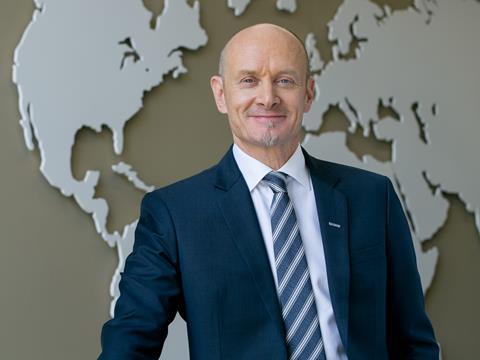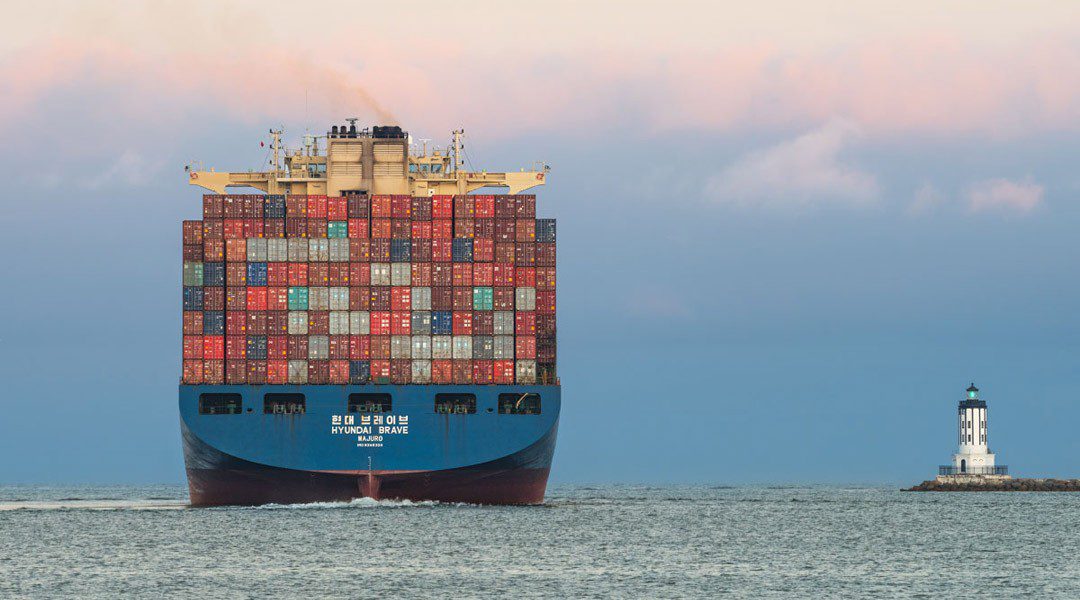Klaus Heim, CEO of WinGD and former-president of CIMAC, underlined WinGD’s commitment to adding ammonia and methanol burning engines to its programme by 2024 during a recent interview.
Speaking shortly before the COP26 conference in Glasgow in late October, Mr. Heim discussed how the Winterthur-based engine designer is broadening its research objectives.
Mr. Heim began the interview by emphasising WinGD’s strong track record in improving the efficiency of its large bore engines, and its continuing emphasis on emissions reduction research.
“It’s kind of our DNA, as an engine designer, to be on top of combustion technology.”
“And of course, [efficiency] is the key focus for our customers, for ship operators. For everyone in this business, it determines the operational cost of the engine, but it also determines the emissions. And that’s what’s now on top of our mind every day.”

Source: WinGD
“It is only a few months since we launched a EUR30 million research programme within WinGD to develop those future fuel technologies that the industry needs,” Klaus Heim, ceo of WinGD tells The Motorship
The Motorship notes that under Mr. Heim, WinGD has seen a significant increase in its R&D budget, and also added a second test engine at its Winterthur headquarters.
Changing research priorities
Coming almost three years after Mr. Heim’s first interview with The Motorship as WinGD CEO in February 2019, Mr. Heim noted that the definition of efficiency had evolved over the course of his 30 year-long career in large bore engines.
“The definition of efficiency itself has changed: in the past efficiency was mainly focused on saving operational costs, reflecting [shipowners’ focus on] paying less when you operate your ship.”
“Nowadays, efficiency has acquired an entirely new aspect,” Mr Heim continued. The Motorship notes that, in previous decades, there was significantly lower interest in economising fuel consumption from an environmental perspective.
The transformation of efficiency also reflected the industry’s success in radically improving the operational reliability of engines, and the performance of individual components. This has resulted in significant improvements in time between overhaul (TBO).
Efficiency solutions
The intensified focus on reducing emissions means that WinGD is being “continuously challenged” to improve the efficiency of both its new engines but also existing engines in its programme.
WinGD had responded with two recent product launches, Mr. Heim noted, citing the recent launch of the X92 B engine. The upgraded version of WinGD’s 920mm bore X92 engine has achieved significant fuel efficiency improvements, and has been very well received by customers in the ultra large container vessel market. “We have received a large number of orders for new large scale container vessels, all with the new X92 B engine.”
A second recent product launch had also met customer demands. WinGD’s iCER technology was a smart solution to the need to improve the efficiency of WinGD’s dual-fuel engine platform while reducing methane emissions. The exhaust gas recirculation-based system offers clear benefits, both in terms of efficiency, and maintenance.
Digitalisation solutions
Mr. Heim noted that while many of the research objectives that WinGD was pursuing were unchanged from 2019 – alternative fuels, digitalisation and emissions control – the company had successfully developed and brought to market solutions over the intervening period.
Digitalisation, or “our industry’s second mega trend”, as Mr. Heim termed it, is presenting similar challenges and opportunities to engine designers, in common with any other industry in this world. “But customers are not asking for digitalisation, customers expect that we offer solutions that use all the possibilities and opportunities that digitalization offers.”
WinGD has already introduced digital technologies that help operators to improve the monitoring of an engine’s operation and a broader vessel’s operation. “Our WiDE solution offers our customers’ expert online support and advice on how to optimise engine operation, to minimise fuel consumption and lower costs.”
Looking beyond condition-based monitoring and predictive maintenance, Mr. Heim anticipated the emergence of new business models, perhaps based on power by the hour contracts used in the power market, where power plant operators simply buy power, devolving the operation of the engines to third parties under guaranteed service agreements.
“We are already seeing the first steps in that direction [in shipping], for example, with the signature of long-term service agreements”. Such service agreements can include guarantees covering engine availability for a certain number of hours per year, stipulating 98% or 99% availability, which the service provider or engine maker is responsible for delivering.
However, the introduction of such solutions was also likely to depend upon the industry accepting the advantages of data sharing. “Data ownership remains one very important boundary condition [for the emergence of more sophisticated data products], given ship operator… [concerns] about competition and data security.” It will require a mindset change, Mr. Heim concluded.
Alternative fuels
Mr. Heim became animated when he discussed the technical challenges facing the industry as a whole. Describing the IMO’s 2050 fleet-level greenhouse gas (GHG) emission reduction target of 50% and the 70% target for lowering GHG emissions from new engines as “huge challenges”, Mr. Heim reiterated that alternative fuels represented the main solution for the industry to the challenge of meeting decarbonisation targets.
“The coming five to ten years will be the years of getting new fuels into our industry.”
This was continuing to inform WinGD’s research objectives, Mr. Heim noted, adding that the company had chosen to increase its investment in alternative fuels. “It is only a few months since we launched a EUR30 million research programme within WinGD to develop those future fuel technologies that the industry needs.”
WinGD has decided to focus on the development of combustion solutions for ammonia and methanol, the two most commonly discussed hydrogen-based fuels. “We expect to have first ships running in 2024-2025 timeframe.” The target was to have the engine “methanol ready” or “ammonia ready”, Mr. Heim added.
The two fuels offer a sustainable pathway to low carbon fuel availability, once green ammonia and green methanol fuel availability is scaled up, without imposing impractical fuel tank size requirements.
The fuels’ combustion characteristics also seem to fulfil the “boundary conditions” of a new fuel reasonably well, Mr. Heim noted, adding that they offered a “good chance to get proper efficiency” in the engine.
LNG will remain a transition option
Turning to LNG, Mr. Heim noted it offered significant CO2 reduction potential at present, but that the reductions on offer were insufficient to meet longer term targets by themselves. LNG would remain a transitional fuel for the industry, despite its increasing adoption as a fuel by segments outside the LNG carrier market. The potential arrival of synthetic LNG (SNG) or bio-methane (LBG) at scale would offer the scope for further improvements in LNG’s footprint. However, Mr. Heim cautioned that bio-methane was likely to face supply constraints, as well as competition from other industries, such as commercial aviation, while the cost of producing SNG via the power-to-x route would need to decline further.
“There does seem to be a common understanding in the entire shipping industry that the direction [of travel] seems to be towards methanol as a liquid fuel or ammonia as a liquid or gaseous fuel.”
Among other technologies under development, Mr. Heim noted on board carbon capture could open up an additional decarbonisation pathway alongside alternative fuels if the technology was ready for deployment on new vessels.
Electrifying the deep-sea fleet
The current second decarbonisation pathway besides alternative fuels was electrification and the use of batteries on board vessels,becoming available, Mr. Heim said.The solution was technologically ready, relying upon mature /PTI technology, and could be used aboard deep-sea vessels in conjunction with a hybrid energy control system.
Mr. Heim was clear that while batteries by themselves would never be capable of generating the amount of energy required to propel commercial shipping, “we do see electrification as offering a path in parallel to the focus on the new fuels.”
The economics of the solution was also attractive. Hybrid energy systems offered “cost savings and CO2 reductions during the operation of the ship”, and would combine the advantages of electric power with the combustion engine.
Broader advantages include lower capex requirements, as the system would permit the elimination of an auxiliary engine compared with a conventional propulsion system. Mr. Heim also noted that there were potential reductions in maintenance costs, as the system would permit assets on board the vessel to be used more efficiently.
WinGD had announced the first order for such as system aboard four PCTCs ordered by Japanese shipping company NYK earlier this year. While a number of ship operators were adopting a wait and see approach to the new technology, Mr. Heim was confident that the potential efficiency and GHG emission reduction savings offered by the system would attract interest, particularly given the rapid evolution in battery technology and declining cost of energy storage systems. “The threshold before ship operators pay serious attention to battery technologies is coming down continuously.”
Industry cooperation
Mr. Heim also noted that as the industry was facing a proliferating range of technical research areas, it was creating greater opportunities for cooperation.Given Klaus Heim’s close association with CIMAC (International Council on Combustion Engines), which he chaired between 2016 and 2019, he was particularly vocal about the important role that industry associations play in formulating and revising common standards, or even in the development of classification rules and future environmental regulations.
Returning to his original R&D theme, Mr. Heim also noted that industry cooperation on early-stage technical research had been successful in the past. The long-running European Union-funded HERCULES programme offered an example of how a collaborative programme involving a number of OEMs, components suppliers, institutes and universities could contribute to the development of pre-commercial low emission technologies.





